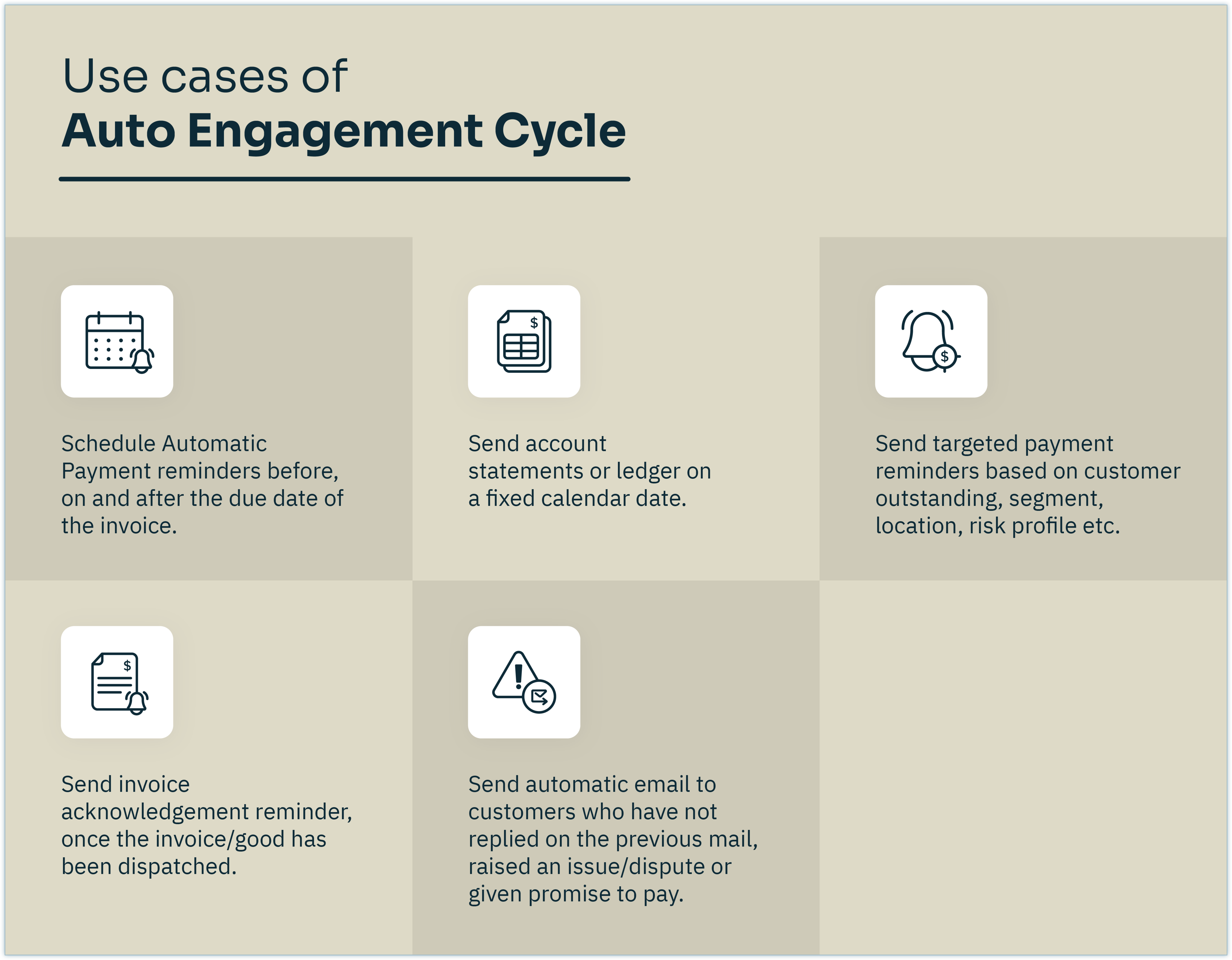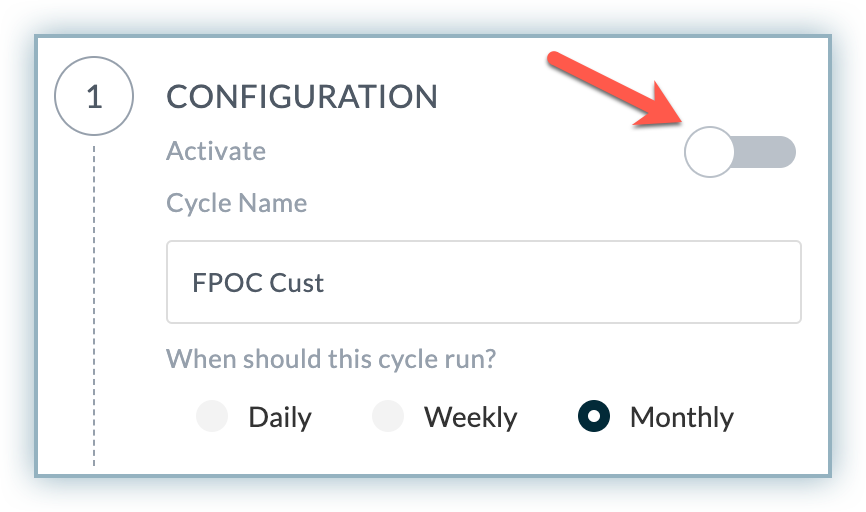Customer Engagement is one of the most important aspects of a business that improve the scalability and profitability of businesses leading to increased exposure and sales. As a business grows, and its customer base expands, the complication of maintaining close engagement with customers becomes more difficult and thus reduces the customer engagement. It's important for businesses that demand ways to automate or streamline customer engagement processes so they can continue to interact effectively with their customers even as their business scales up.
Auto Engagement;an efficient and cost-effective solution not only helps you schedule automated emails & SMS reminders for the customers, but also provides clear visibility on your customer's engagement with product/services. Regardless of any business function, it allows you to maximize the performance of the business collection processes and gain competitive edge over the customer engagement. You can also measure the performance of each cycle and reminder you sent to the customer by generating client engagement report.
Contact your admin to get access to this feature.
Auto Engagement is an automation tool in Receivables that allows you to send automatic recurring reminders (via email and SMS) to your customers using rules based on simple to complex business functions. There can be many use cases of using auto engagement where it helps businesses improve their productivity and increase the customer engagement.
The following illustration demonstrates some common use cases of Auto Engagement in businesses.

This feature is only accessible to specific user roles. For more information, see setting up roles and permissions in Receivables.
Can't find the use case you need? Contact Chargebee Receivables Support .
Chargebee Receivables auto engagement cycle enables you to automate the channelisation of collection activity process by engaging more targeted customer to pay early.
Here are the major steps visualized in the auto engagement cycle phases.

Before scheduling an auto engagement cycle for your AR profile, it goes through the following phases:
Cycle Planning and Creation Phase: Planning an engagement cycle involves a number of steps from adding a new cycle to configuring cycle details. For a typical business function, you can create multiple cycles and configure each one of them based on various frequencies. See, Creating Auto Engagement Cycle.
Setting Target Customers for Cycle: By default, all the customers are included whenever a specific cycle is defined. It's beneficial for businesses to plan the cycle for specific customers to adapt the robustness of auto engagement cycle. This gives you complete control over the engagement cycle, and to whom the reminder should be sent.
Cycle Rules Assessment: Cycle rule assessment is another phase of auto engagement cycle that ensures all the business functions are implemented in cycle rules correctly and business collection activities are organized and up-to date. The assessment helps you make necessary adjustment in the cycle rules so that automatic reminders always reach the right customers with right set of invoices based on specific conditions/rules.
Adding Cycle Reminders: Adding reminders to the cycle is one of the important phase in auto engagement cycle that helps you schedule automatic reminders(email and SMS) for the customers. You can configure multiple reminders in one cycle and each reminder can have their own set of rules defined so that the reminder goes to the targeted customers.
Auto Engagement Cycles enables you to create reminders cycle for your business collection activities and incorporates automation processes into your collection.
To create a new cycle and schedule a reminder for a particular collection activity specific to a customer, refer to the following operations that have to be executed sequentially:
Adding a new cycle enable you to configure the cycle rules and reminders that execute during the cycle. You can configure the cycle rules and reminders after creating a new cycle. The frequency can be controlled regardless of whether the cycle is an existing or new one through the selection of weekly, monthly, or daily frequency.
To add a new cycle, follow these steps:
Click Settings > Communication > Auto Engagement Cycles.
In the Auto Engagement Cycles page, click +Add Cycle.

Enter the name of cycle and select a Frequency.

Click Save.
Once a cycle is added, it will redirect you to Cycle details page where you can define the properties of a cycle such as cycle rules, reminders, and so on.
By configuring an existing or newly created cycle, you can specify the cycle rules and reminders that should be sent to the customers. You can configure the following details of a cycle in the Cycle details page:
In the Cycle Details page, you can configure the following details:
Enable/Disable Cycle: You can enable/disable any cycle that is irrelevant or inactive using the toggle button. In addition, you can also enable/disable a specific engagement cycle from the Auto Engagement Cycles page.
Cycle Frequency: You must select a frequency to run the cycle based on daily, weekly, and monthly frequency.

With engagement cycles, you can schedule automatic emails and SMS reminders for specific customers that reminds them about payments, overdue invoices, and other activities related to collections. You can include/exclude customers by adding them to a list and uploading the list to the reminder cycle.
A total of 300 out of 2000 customers in a business assigned to a collector have paid their bills. Now collectors can use the Auto Engagement Cycle to exclude those 300 customers from a weekly reminder cycle.
To Include/exclude customer in a cycle, follow these steps:

You can set user's visibility based on the customers that are applicable to be included in the cycle. For more information, see setting user's roles and visibility.
Engagement cycles are a great way to gain customers and improve the customer experience in business. Receivables allows you to implement your business function and automate the customer engagement process by creating multiple rules in an engagement cycle. Cycle rules determine which customers will receive a reminder for which invoices/transactions.
You can manage all different rules and reminders in an engagement cycle by adding new rules, updating existing rules, and changing the order in which the rules are applied.
Cycle rules can be defined based on two categories:
At Customer level: Cycle rules that are defined at customer level. You can define cycle rules based on the following sub-categories:
At Document level: Cycle rules that are defined at invoice/document level. At document level, you can define cycle rules and select the conditions based on the following sub-categories:
At Payment level: Cycle rules that are defined to address payment failures and ensure that customers are promptly notified of any issues with their payments. You can define payment level rules based on the following sub-categories:
Cycle rules are automatically applied to newly created cycles (at the customer and document level) in Receivables. You may edit or delete these rules at any time.
| Category | Cycle Rule |
|---|---|
Customer |
Outstanding is greater than 0 |
| Customers which does not have mismatch | |
| Document | Amount is greater than 0 |
| Balance is greater than 0 | |
| Document Type includes Invoice | |
| Exclude Documents paid via Payment Gateway |
To create a cycle rule, follow these steps:
In the Cycle Rules section, click +Add Rules.
On the Manage Rules page, you can add the following attributes such as:
Click Save.
The following illustration creates a cycle rule at the customer level for which overdue amount is greater than USD1000.

Contact Chargebee Receivables Support to define a new custom field at customer or document level in your AR profile.
After defining cycle rules, you can edit or delete them with a single click. In a cycle, you can define a cycle rule in two ways:
You can edit/delete a cycle rule at any level by clicking on the icon appearing next to the cycle rule.
To edit/delete a cycle rule, follow these steps:
With reminders, you can automate the email and SMS reminder workflow in your collection activities. You can add as many reminder as you want in a cycle based on specific rules. reminder is always created based on the selected frequency of the cycle.
For example, if you create monthly frequency cycle, you have to add a reminder that will be sent to customers on a certain date of every month.
To add a reminder in a cycle, follow these steps:
The following illustration creates an outstanding email reminder for all the customer based on the defined cycle rules, and included/excluded customer in the cycle.

With the Multi-Language functionality in place, before sending the emails, Receivables will check the customer locale and also check if the required email template is available in the customer locale. If available, it will send it in the customer locale, otherwise, it will send it in English (default language).
By default, cycle rules include one or more reminders that run at a predetermined frequency. For specific reminders, cycle rules can be customised that allows overriding the existing cycle rules and setting up the reminders accordingly.
To add/override cycle rules in a reminder, follow these steps:
Once rules are added at the reminder level, you can click View to see all the rules defined under that reminder. You can also edit/delete defined cycle rules at the reminder level.
The following illustration creates a document level cycle rule under the outstanding email reminder for which balance must be greater than USD1000.

Once reminders are added to a cycle, you can edit/remove the reminders from it. Editing a reminder allows you to edit the name, frequency, and other reminder details.
To edit/delete a reminder, follow these steps:
If you wish to delete the selected reminder, you can click the Bin icon next to it.

Contact Chargebee Receivables Support to define a new custom field at the customer or document level in your AR profile.
If you disable a reminder in a cycle, all the cycle rules associated to it will also get disabled. Once a reminder is added in a cycle, you can either activate or disable it from the Cycle Details page.
To disable a reminder, follow the steps:
Select a specific cycle and open the Cycle Details page.
Under Reminders section, click toggle off button to disable the reminder.

Disabling a cycle will disable all the defined rules and reminders associated with it. To disable a cycle, navigate to main page or under the Cycle Details, turn off the toggle button next to the cycle.
If you decide to enable the cycle again in the future, any previously added cycle will be available unless it is not deleted.

Deleting a cycle will also delete the respective cycle rules and reminders.
To delete a Cycle, follow these steps:
You can set up multiple engagement cycle to automate the reminder process in your business. It is essential for businesses to know which cycle is driving well and getting better customer responses.
With client engagement email and SMS report it's fairly easy to analyze the performance of all the defined cycle. You can further use the reports to analyze your customer's follow ups on reminders that helps you make better decision in managing the business cash flow.